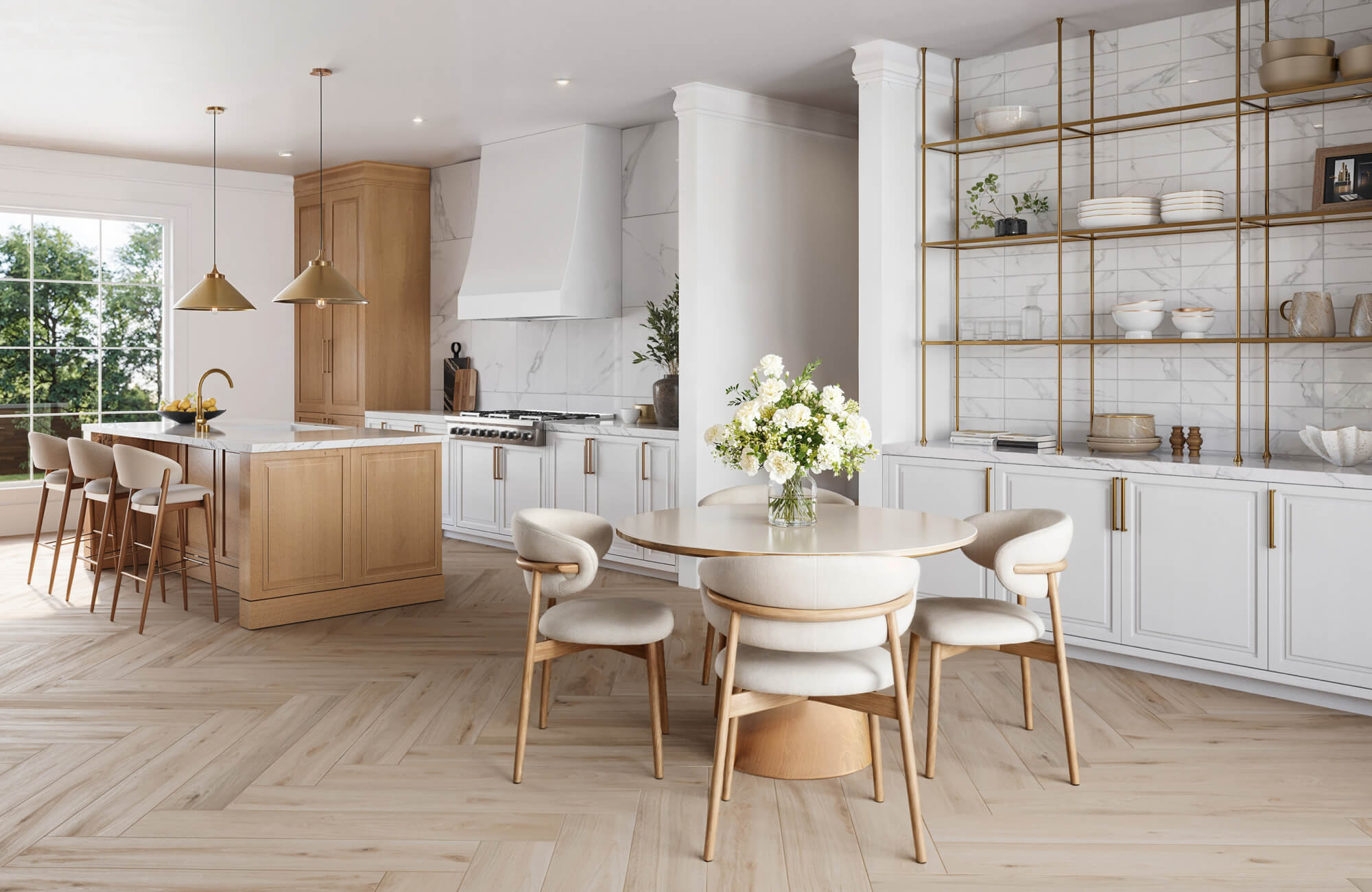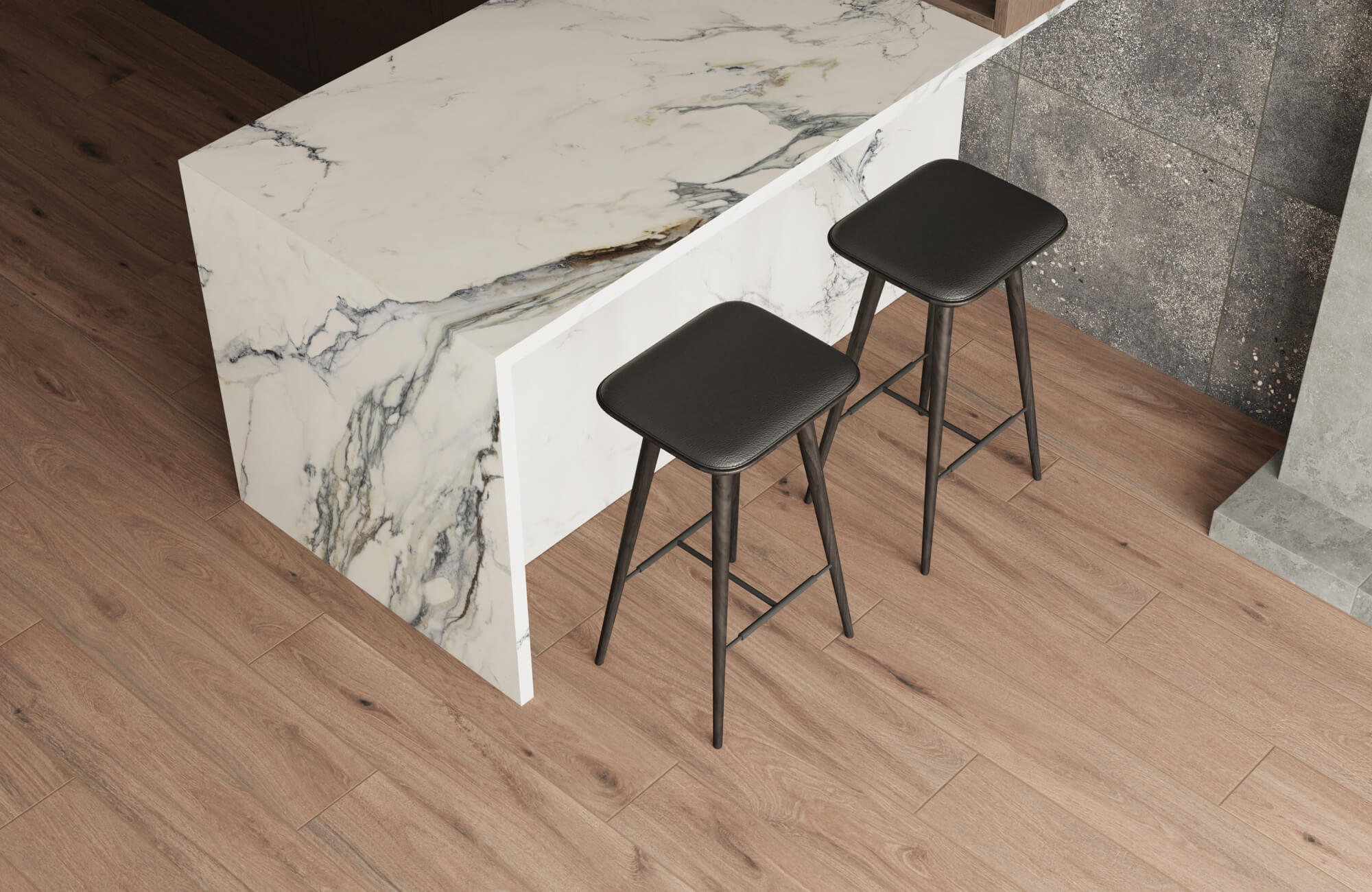Marble, a timeless and luxurious natural stone, has been admired for centuries for its elegance, durability, rich color spectrum, and unique veining. However, certain marble colors, due to their rarity and appeal, command significantly higher prices, making them a true statement of opulence in high-end design. For those who love the marble look but are mindful of the cost, marble look tiles offer an affordable alternative that brings the sophistication of marble to a variety of spaces, from kitchen backsplashes to bathroom walls.
So, which marble color is the most expensive? While it’s challenging to identify one single top-priced color, certain rare hues have become symbols of luxury due to their scarcity and striking beauty. Below, we’ll explore these prized colors and what makes them especially valued in luxury design.

The Influence of Marble Color on Design and Value
Marble’s color has a profound impact on its appeal and market value in the luxury design world. From classic whites and blacks to unique greens, reds, and blues, each hue brings a distinct aesthetic that shapes its application in high-end interiors. Here, we explore the design potential and premium value of marble colors with the highest prices.
White Marble: The Epitome of Elegance
White marble, particularly varieties like Statuario and Calacatta, is often considered the epitome of luxury. These Italian marbles are renowned for their luminous white backgrounds, intricate veining patterns, and timeless elegance. The purity of their color, combined with the delicate dance of veins across the surface, creates a stunning visual effect that elevates any space.
These specific marble varieties' distinctiveness and high demand contribute to their premium price. Quarries in Carrara, Italy, have produced these exceptional marbles for centuries, but the supply remains finite. The beauty and history of white marble—famously used in sculptures like Michelangelo's "David"—make it particularly desirable. As demand continues to outpace supply, the value of these white marbles steadily rises.
Although the allure of white marble is undeniable, it's not the only color that holds an elite status in the world of luxury design. Other colors, each with distinct qualities, have also become iconic choices in high-end interiors.
Black Marble: A Dark and Mysterious Allure
Black marble, such as Belgian Black or Black Marquina, offers a dramatic and sophisticated alternative to white marble. Its deep, uniform color and polished surface create an opulent and mysterious ambiance that makes an impact in refined interiors, from upscale restaurants to private residences.
The formation of black marble involves specific geological conditions, which lead to its distinct dark color and scarcity. The absence of significant veining and impurities contributes to its clean, elegant appearance, adding to its appeal among designers. However, extracting large, flawless blocks of black marble is challenging, impacting both its availability and price.
For those seeking the iconic look of black marble without the associated cost and maintenance, Edward Martin’s Leona 24x24 Matte Porcelain Tile in Nero Marquina presents an excellent alternative. This tile replicates the deep black hue and subtle veining of natural Black Marquina marble, delivering an equally striking look with enhanced durability and ease of maintenance. With a refined matte finish, the Leona tile suits both floor and wall applications, allowing for the creation of luxurious interiors in spaces like bathrooms, kitchens, and living rooms. Notably, it is crafted using 95% locally sourced materials and contains up to 45% recycled content, making it a sustainable choice for eco-conscious design.
Colored Marbles: A Spectrum of Luxury
Beyond the classic shades of white and black, certain colored marbles also command high prices, especially when they display vibrant patterns. Green marbles, such as Verde Alpi and Verde Guatemala, are celebrated for their deep, earthy tones and intricate veining. Red marbles, like Rosso Levanto, offer a bold statement with their dramatic color, while rare blue marbles, such as Azul Macaubas, are prized for their rich, captivating hues.
Prices for colored marble can vary greatly based on factors like color intensity, pattern complexity, and the stone’s overall quality. These unique colors are often chosen to add character and individuality to grand spaces, making a vivid statement without losing the sophistication that marble brings.
Yet, even as these colors enhance interiors with their vibrance, the costliest marbles are not just defined by their colors alone. Other essential factors contribute to the value of these superior stones, making them even more coveted in high-end projects.

Factors Beyond Color
Beyond color, factors like rarity, quality, and origin impact a marble’s value. High-quality marble with uniform color, consistency, and minimal flaws is often more expensive. Likewise, a marble’s origin or cultural significance can elevate its status and demand.
Rarity and Limited Supply
The rarity of a specific marble variety has a significant impact on its price. Limited access to high-quality quarries, especially those subject to strict mining regulations, restricts the availability of certain marbles. Historical significance and cultural associations further increase demand, elevating the value of these marbles. For instance, Makrana marble, used in India’s iconic Taj Mahal, commands high prices due to its historical prestige and unparalleled durability.
Quality and Consistency
The quality of marble, as defined by factors like color consistency, veining patterns, and lack of defects, is crucial to its valuation. High-quality marble should exhibit a uniform color, minimal veining, and no visible cracks or fissures. Consistent color and texture also enhance the stone’s aesthetic appeal and raise its value in the luxury market, as even a minor flaw can reduce the perceived quality and worth of the stone.
Origin and Provenance
The provenance or documented origin of a marble piece adds value, particularly for rare and historic types. Quarries in places like Carrara, Italy, and Makrana, India, are renowned for producing the finest marble varieties worldwide. Certified quality standards provide further assurance of the stone’s authenticity, a valuable trait in any luxury purchase.
While these factors enhance the value of marble, they also drive up the associated costs. Each stage of the marble’s journey from quarry to installation contributes to its final price, as we’ll examine next.

A Breakdown of Costs
The price of marble encompasses many factors, from quarrying to final installation. Marble’s extraction and processing require specialized skills and equipment, which increases costs. This section examines each stage in the process and how it affects marble's price.
Quarrying and Processing
Marble’s journey from quarry to finished product is both labor-intensive and costly. Extracting large blocks from underground mines or open-pit quarries requires skilled labor and specialized machinery. Once removed, these raw blocks are transported to processing facilities, where they are meticulously cut and polished.
Cutting marble into slabs also demands precision and expertise. Diamond-tipped saws are used to slice through the stone, after which slabs are refined to achieve the desired thickness and finish. Polishing involves a multi-step process that enhances the stone’s natural beauty. The labor-intensive nature of these processes, combined with the high cost of specialized equipment, adds to the marble’s final price. Stringent quality control during these processes ensures that only the finest slabs reach the market.
Transportation and Logistics
Transporting marble, particularly from remote quarries, incurs significant costs. Large marble blocks are carefully packed and secured for transit, often requiring specialized shipping containers and vehicles. The journey from the quarry to the processing facility and finally to the installation site can greatly affect the final cost.
In addition to transportation, international trade regulations, such as tariffs and taxes, impact marble prices. Exotic varieties sourced from far-off locations, like Azul Macaubas from Brazil, can have considerable import-related costs. These logistical aspects add to the exclusivity and price of certain marbles.
Supply and Demand Dynamics
Supply and demand are central to determining marble prices. When demand rises, especially in growing economies with a strong interest in interior design, prices also increase. Conversely, reduced demand can temporarily lower prices.
Design trends further shape marble popularity and cost. When particular types become prominent in sophisticated architecture or gain popularity among renowned designers, demand often surges. For instance, luxury brands frequently select exclusive marble varieties to distinguish their projects, driving up prices.
Ultimately, the intricate processes involved in quarrying, transporting, and finishing marble significantly drive up its cost, making it an exquisite material. For those seeking marble’s elegance without the expense, marble look tiles offer a stunning, affordable alternative.

Marble Look Tiles as the Affordable Alternative
While authentic marble brings a sense of history and grandeur, marble look tiles offer a modern solution that combines style with practicality. Through advanced manufacturing techniques, these tiles replicate marble’s intricate veining and natural tones at a fraction of the cost. Ideal for households and commercial spaces that prioritize durability, marble look tiles provide a worry-free alternative to this natural stone. Both porcelain and ceramic, popular materials in tile manufacturing, have unique advantages in capturing marble’s timeless beauty.
Porcelain Marble Look Tiles
Porcelain marble look tiles deliver the luxurious aesthetic of natural marble while offering remarkable durability and resilience. Engineered to withstand the demands of high-use areas, these tiles are non-porous and highly scratch-resistant, making them ideal for kitchens, bathrooms, and other spaces that benefit from durability without sacrificing style.
Modern advancements in tile manufacturing have elevated porcelain marble look tiles to capture the intricate veining and textures that characterize authentic marble. A prime example is Edward Martin’s Aniston 24x48 Matte Porcelain Tile in Calacatta Antico, as seen in the picture above. Whether you’re envisioning a spa-like bathroom or a sophisticated hotel lobby, this Aniston tile brings a touch of timeless elegance to any space. Its versatility complements a range of interior styles, from traditional to modern, and the tile’s durability allows it to perform well in both walls and floors of residential and commercial settings alike.
The ease of maintenance and resistance to staining also make these porcelain marble look tiles an ideal choice for busy households that seek both opulence and practicality. These tiles require minimal upkeep to retain their high-end appearance, providing a lasting, beautiful addition to any space. For the best results, however, following the manufacturer's guidelines helps ensure the tile’s durability and appearance are preserved over time.
Ceramic Marble Look Tiles
Ceramic marble look tiles offer a versatile, budget-friendly option with the beauty of marble at a lower cost. Using advanced printing technology, these tiles replicate the fine details of marble veining, making them an elegant choice for walls and backsplashes. Their lighter weight and variety of size options also allow for easy installation and design flexibility. Suitable for lower-use or decorative areas, ceramic marble look tiles bring an affordable touch of sophistication while remaining low maintenance and easy to clean.
For those exploring options, Edward Martin’s augmented reality (AR) tool allows you to visualize how these marble look tiles will look in your space, making it easier to find the perfect match. This innovative tool offers a seamless design experience, bridging inspiration with practical decision-making to bring luxurious marble aesthetics to life in any setting.
Marble look tiles offer a cost-effective alternative to natural marble, but their true impact lies in the finish. Each finish—glossy, polished, matte, and textured—adds unique character and functionality, allowing you to achieve a refined, cohesive look. Let’s explore how these finishes can enhance your interiors.

Elevating Interiors with Marble Look Finishes
Modern marble look tiles come in a range of finishes that capture the beauty and elegance of natural stone, allowing designers to tailor interiors to their desired look and feel.
A glossy or polished finish brings a reflective, light-enhancing quality that elevates brightness, making it ideal for spaces seeking an open, airy ambiance. This finish replicates the luxurious sheen of natural marble, adding a high-end look to bathrooms, kitchens, and living areas.
Matte finishes, on the other hand, lend a softer, more understated appeal. The muted surface offers a contemporary, relaxed aesthetic that’s perfect for creating a warm, welcoming atmosphere, especially in residential settings. This finish also provides a slip-resistant surface, making it practical for busy, high-moisture areas.
Satin finishes strike a balance between gloss and matte, offering a velvety, soft sheen that exudes sophistication without overwhelming shine. The satin finish works well in transitional spaces, providing a refined look that blends modern and traditional aesthetics, ideal for adding subtle elegance to hallways, entryways, and living rooms.
For those who appreciate tactile depth, textured finishes provide an added layer of visual and sensory interest. Edward Martin’s Alessandra 13x39 Leathered Ceramic Tile in Arabescato Deco (shown in the photo above), with its 3D fluted design, is a prime example. This finish brings a dimensional, artisanal quality to feature walls, backsplashes, and other statement areas, giving spaces a unique marble-inspired look that feels both natural and luxurious.
Final Thoughts
Marble’s pricing is influenced by a complex mix of factors, including color, rarity, quality, and origin. White and black marbles often command the highest prices, celebrated for their elegance and demand, while unique colors, like blue and green, add individuality and value to luxury designs. Porcelain and ceramic marble look tiles also offer a durable alternative that captures marble’s beauty without the high price or maintenance needs.
For those looking to experience the refined elegance of marble look tiles firsthand, Edward Martin’s 4" x 4" samples provide an accurate representation of each marble look tile’s color and finish. These samples offer a reliable preview of our premium collections, allowing you to make confident choices for your space.







